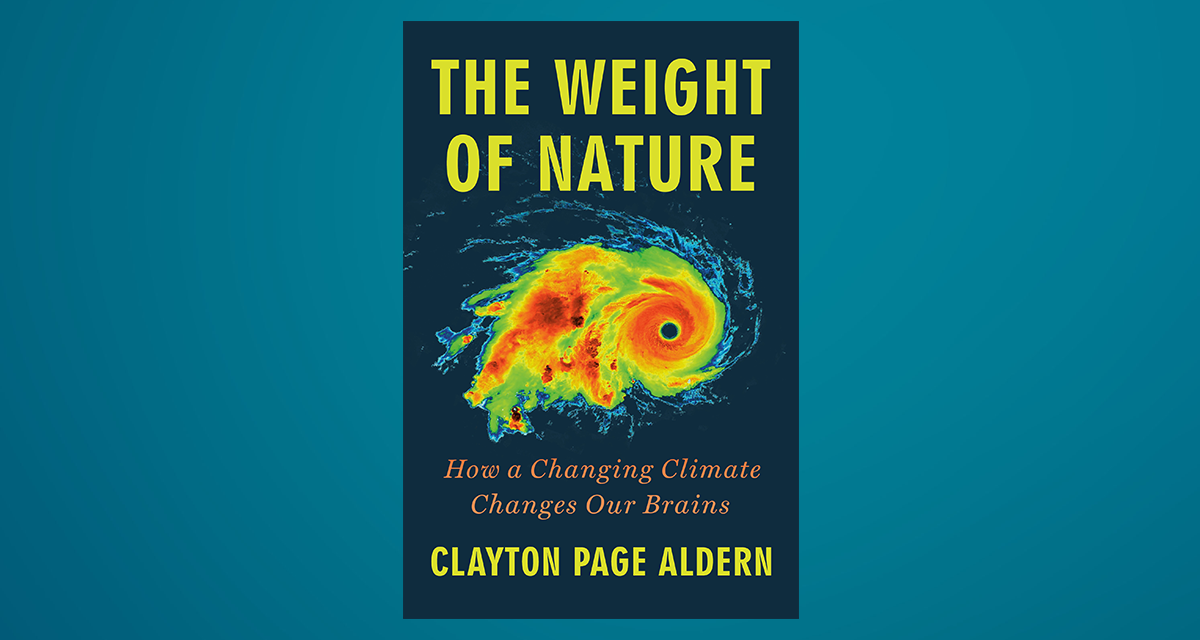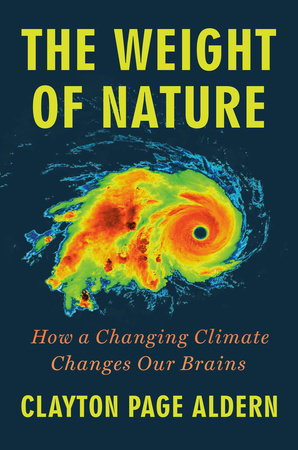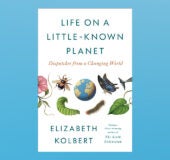The march of climate change is stunning and vicious, with rising seas, extreme weather, and oppressive heat blanketing the globe. But its effects on our very brains constitute a public-health crisis that has gone largely unreported. Based on seven years of research, this book by the award-winning journalist and trained neuroscientist Clayton Page Aldern, synthesizes the emerging neuroscience, psychology, and behavioral economics of global warming and brain health. A masterpiece of literary journalism, this book shows readers how a changing environment is changing us today, from the inside out.
Aldern calls it the weight of nature.
This book is about the neuroscience and psychology of how a changing world changes us from the inside out. It is not a book about climate anxiety—about worrying about climate change—though we’ll touch briefly on the seriousness of the subject later on. It is also not a book about climate communications or climate politics and the manners in which the psychological dimensions of the climate problem lend themselves to complicating those arenas. That’s important stuff; you can read about it elsewhere. I also won’t wade too deeply into the trenches of consciousness, though a useful reminder- mantra might be: The mind is grounded in the brain and the body. Mental energy is physical energy. There; that’s about all you’re going to hear from me on neurophilosophy. In this book, instead, you’ll only find evidence of direct interventions of environmental change on the brain and mind. That is the scope of this thing.
Here is who I am and why I care about any of this mess. These days, I often introduce myself as a recovering neuroscientist. Back in 2015, when I first conceived this project, I had just finished a short graduate program in neuroscience at the University of Oxford, and I was spending much of my time fiddling with a programming language called MATLAB, trying to replicate in a computer the results of an experiment someone had conducted on zebra-finch brains. I was known as a laboratory technician. I worked in a place called the Centre for Neural Circuits and Behaviour. I’d thought I’d landed my dream job. I was concurrently enrolled in a graduate degree in public policy. I drank cask-temperature ale and cold Pimm’s cups and played rugby and puttered around in boats called punts and occasionally wore a formal cape. Charmed life. I’m still grateful today.
To be blunt, though, it all felt a little disconnected from the world that existed outside the Centre.
And then a friend showed me a report from the Pentagon. Earlier that year, the Department of Defense had quietly submitted a slim report to Congress on the national security implications of a changing climate. The fourteen-page document, written in the well-oiled, acronym-heavy prose of the military apparatus, was remarkable in what it laid bare. Not only did Defense—not exactly Greenpeace—see climate change as a serious threat to national security; it noted that these effects were already occurring. The mid-2000s Syrian drought, in its choking of agriculture and flame-fanning of mass displacement, had helped spark the Syrian civil war. In 2012, on home turf, when Sandy crashed those torrents of storm water through the hallways of New York City, the Defense Department was forced to mobilize twenty-four thousand personnel. To the military and intelligence brass, climate change wasn’t hypothetical. We were already fighting it.
Most astounding in the July 2015 report, though, was a framing of how a changing climate acted on our security. For the Department of Defense, climate change wasn’t about rising temperatures and sea-level rise. Those concerns were secondary to something more human: the global climate’s ability to “aggravate existing problems” like poverty, social tensions, ineffective leadership, and weak political institutions. It wasn’t just that a warmer world would hurt us outright; it was that a warmer world would make us hurt one another. I remember a jigsaw piece snapping into place in my head.
A few months before the submission of the Pentagon report, a Stanford economist named Marshall Burke and two of his colleagues had published an article in the Annual Review of Economics about the relationships between climate and conflict. Surveying dozens of independent studies, the team illustrated how deflections in temperature or rainfall patterns were associated with increases in both large-scale conflicts and individual violent crimes. The extraordinary finding here, surfacing again and again in the studies Burke’s team reviewed, was that these crime spikes couldn’t be pinned to things like income or food insecurity. The statisticians could correct for all those effects. There was something else going on.
It’s the kind of finding that sets off alarm bells in the ears of neuroscientists. With a Stanford professor and now the Department of Defense claiming temperature changes were somehow intimately related to violence, I began to wonder which tangle of neurological pathways might be at work—which strands, if any, could be separated from the geopolitics and the sociology and the anthropology—and what this rat’s nest might mean for a warming world. Climate change was always out there, in that other place and future time. If droughts and rising temperatures were doing something to people now, in here, that most personal of spaces, it seemed worth asking how and why. I channeled my policy degree into climate policy; I left the lab for environmental journalism. This book is the product of the seven years of research that followed.
As suggested earlier, the link between temperature and aggression is the tip of a melting iceberg. As I dug into the neuroscience of environmental change, evidence of invisible forces emerged by the truckload. A changing Earth was infiltrating our internal worlds, guiding our hands, and putting words in our mouths. The environment was everywhere. And of course it was. I was a fish coming to understand water for the first time.
Together, the chapters presented here represent a fundamental piece to the environmental puzzle that in our climate modeling, policymaking, and personal lives we are broadly ignoring—to our own detriment. The effects of climate change on our brains constitute a public health crisis that has gone largely unreported. And it is past time to act. Immigration judges are more likely to reject asylum applications on hotter days. Some drugs that act on the brain aren’t as effective at higher temperatures. Wildfires evict us; chronic stress becomes clinical. In the world of disease vectors, climate-fueled ecosystem changes are expanding the reach of everything from the mosquitoes of cerebral malaria fame to brain-eating amoebae most of us have no reason to have ever even heard of. Major depression symptomatology skyrockets with landscape loss. Your high schooler is going to lose a couple of points on the SAT if they take it on a particularly hot day. We are already victims of the climate crisis, whether we know it or not.
Which is frightening. It should be, anyway. It frightened me when I began to understand it, and it frightens me now.
I don’t seek to leave you in the fetal position, though. And I don’t think that needs to be our response. I feel this way for a couple of reasons. The first is that some of our impending public health nightmare is not without solutions. Some are technical in nature: infectious disease protocols, pharmacological fixes, stopgaps like air-conditioning and air-filtration systems. But much of the psychological, mental, and emotional resilience here will be rooted in techniques adapted from psychotherapy and the behavioral sciences—adaptation responses we can all apply to creatively channel grief, avoid burnout, reclaimagency, and find purpose in the face of an arbitrary, unjust future. Feeling a changing climate may be the means by which we ultimately respond to it. Collective action can foster connection and grit. We have storytelling too: that ancient means by which we acknowledge and name our experiences, enter the minds of one another, and hone the imperfect art of empathy. There are some unifying, connective principles here. They can ground us.
But first we have to pay attention.
In a 2016 interview with The New York Times, Barack Obama called climate change “a slow-moving issue that, on a day‑to‑day basis, people don’t experience and don’t see.” Indeed, until recently, most of us tended to read climate change as an abstract idea: this slow, plodding thing inching across borders and generations. We only paused to really think about it when that plodding was punctuated by those aberrant hurricanes and hundred-year wildfires. Just a few short years after Obama’s interview, it’s no longer true: We see evidence of climate devastation in headlines, in photographs, and through our windows every day. Environmental change is no longer just in our periphery. Philadelphia’s summer is like Atlanta’s used to be just a few decades ago. Atlanta, for its part, now has summers like Tampa’s. Recent wildfire seasons have illustrated in drastic orange and black the roaring consequences of an untamed climate. Hurricanes are swallowing coastal neighborhoods. July 2021 saw simultaneous extreme weather on four continents, from lethal flooding in Western Europe to raging forest fires in Siberia to China’s heaviest rain in a thousand years.
There’s more to see here than extreme weather, though—if we know where to look. The neurological, emotional, and behavioral effects of environmental degradation can pull our understanding of climate change out of the future and into the present. The climate has changed, it continues to do so, and millions of people are already facing the consequences. By centering human experience as it relates to a changing climate, we can give tangible contours to the formless. The twisted, humbling paradox of it all is that we perhaps only ever needed to look inside ourselves.
Doing so today can help us better conceptualize this crisis—the greatest existential crisis humanity has ever faced—acknowledge and foster resilience in our responses to it, and lift up viable solutions for navigating our new normal. In short, we can grasp the importance of global environmental change by more deeply considering ourselves. Social scientists tell us that climate change demands emotional engagement if policymakers are to listen and act. I think that’s almost right. People can and ought to connect with a changing climate on emotional terms—but if the climate is already changing us, we already do.
There is a certain kind of introduction to a certain kind of book written over the course of the coronavirus pandemic. It goes something like: And then the world changed, and we recognized the degree to which everything was interconnected—how your health influenced mine; how structural power dynamics shaped access and opportunity—and we realized this project wasn’t just a collection of pirate-themed cocktail recipes; it was also a history of empire and white supremacy.
This book, the one in your hands, does not profess much moral clarity, nor has its thrust changed much over the course of the pandemic. It is a project predicated on interconnectedness, but to state as much feels like reminding someone that their feet are on the ground because of gravity. It’s axiomatic enough to be uninteresting.
It’s true, though, that much of the writing here took place during a time of great consequence and mass death. It feels worth naming as much. Under pandemic waves—the curves we needed to flatten—the world became smaller. The waves pressed. They threatened to flatten us.
There is another wave coming. This book is sympathetic to the idea that the climate crisis is going to get worse before it gets better—and that we are drastically underestimating (and failing to articulate) many of the risks there in. But I don’t think this story has to be exclusively one of fear. You can think of the following chapters as insurance brokers: They say, Look, here are the risks we ought to be enumerating and hedging against. We know that climate change bears on memory systems and cognition and impulsive aggression. We know it infuses the water and air with neurotoxins; that it increases the range of brain-disease vectors; that extreme weather can spurpost-traumatic stress disorder. We know that a changing climate can act intimately on our sensory systems. It can seed anxiety and depression. It can corrupt language and, by extension, our perception of reality. The waves of the climate crisis are already bearing down, whether we accept it as fact or not. The question is: How will we stay above water?
I submit, perhaps a bit too earnestly for a book I’m encouraging you to take seriously, that we have to keep each other afloat. There is room on the lifeboat. Much of this text assumes an understanding of the world reaching inward. But we can reach out too, against the weight of the wave, and not just in a blind grope. People caused the climate crisis and its resulting neurological effects, and it will be people, in solidarity, who reverse it. It will be people who foster resilience in one another. You will find examples of this resilience in these pages.
The text is split into three parts. The first focuses on the influential action of climate change on behavior: its sapping of our perceived free will through the lens of memory systems, cognition, and aggression. The second considers the manners in which a changing environment enters explicitly into friction with neurological health. I cover environmental neurotoxin exposures bolstered by climate change, climate-fueled infectious brain diseases, and extreme mental trauma. The third and final section concerns subtler actions. It is about how climate change and environmental degradation infiltrate sensory systems like olfaction and audition; how climate change influences pain communication and major depression; and how it insidiously shapes language and perception. It is an unnerving, heavypile of evidence.
But this book is not the wave. It is a hand reaching out. Hold on.
Copyright © 2024 by Clayton Page Aldern. All rights reserved. No part of this excerpt may be reproduced or reprinted without permission in writing from the publisher.

© Bonnie Cutts
Clayton Aldern is a neuroscientist turned environmental journalist whose work has appeared in The Atlantic, The Guardian, The New Republic, Mother Jones, Vox, Newsweek, The Economist, Scientific American, and Grist, where he is a senior data reporter. His climate change data visualizations have appeared in a variety of forums, including on the US Senate floor in a speech by Sen. Sheldon Whitehouse.
A Rhodes Scholar and a Reynolds Journalism Institute Fellow, he holds a master’s in neuroscience and a master’s in public policy from the University of Oxford. He is also a research affiliate at the Center for Studies in Demography and Ecology at the University of Washington, a grantee of the Pulitzer Center, and has contributed to reporting teams that have won a national Edward R. Murrow Award, multiple Online Journalism Awards, and the Breaking Barriers Award from the Institute for Nonprofit News. See claytonaldern.com or follow him on Twitter @compatibilism.






